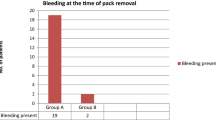Abstract
Although effects of Merocel® nasal packs and silicone splints on nasal flora alterations and bacteremia formation after septoplasty were assessed before, the effect of transseptal suturing technique has not been studied yet. The objective of this study is to compare nasal flora alterations and bacteremia occurrence rates between Merocel packs, silicone splints, and transseptal suturing technique in septoplasty. Ninety patients were divided into three groups randomly: Merocel packing (Group M), silicone splint (Group S), and transseptal suturing without packing (Group T). Group M and S received prophylactic antibiotics and antibiotic pomade application to packs, whereas neither antibiotic prophylaxis nor topical pomade was applied to Group T. Preoperative, after pack removal and 1 month after pack removal nasal swab cultures and preoperative, immediately after surgery and 24 h after surgery blood cultures were taken from all patients. Group M increased Methicillin-sensitive Staphylococcus aureus (MSSA) colonization (p = 0.003) and decreased normal flora colonization (p = 0.038), whereas Group S and T did not affect MSSA or normal flora colonization (p > 0.05). Antibiotic prophylaxis did not affect MSSA colonization (p = 0.14), whereas decreased normal flora colonization (p = 0.029). Transseptal suturing did not prevent bacteremia formation. Postoperative increasing of MSSA colonization in nasal cavity for septoplasty patients can be prevented by using transseptal suturing technique or silicone splints instead of Merocel packing, rather than applying prophylactic antibiotic treatment. Using transseptal suturing does not prevent bacteremia formation during septal surgery. These findings should be kept in mind to prevent postoperative life-threatening infective complications of septoplasty especially in immunosuppressive patients and patients with cardiovascular diseases.


Similar content being viewed by others
References
Ozcan C, Vayisoglu Y, Kilic S et al (2008) Comparison of rapid rhino and Merocel nasal packs in endonasal septal surgery. J Otolaryngol Head Neck Surg 37:826–831
Gunaydin RO, Aygenc E, Karakullukcu S et al (2011) Nasal packing and transseptal suturing techniques: surgical and anaesthetic perspectives. Eur Arch Otorhinolaryngol 268:1151–1156
Yilmaz MS, Guven M, Elicora SS et al (2013) An evaluation of biodegradable synthetic polyurethane foam in patients following septoplasty: a prospective randomized trial. Otolaryngol Head Neck Surg 148:140–144
Kaygusuz I, Kizirgil A, KArlidag T et al (2003) Bacteriemia in septoplasty and septorhinoplasty surgery. Rhinology 41:76–79
Sharma A, Philpott C, Pope L et al (2007) Methicillin resistant Staphylococcus aureus: is it a problem for nasal surgery? J Laryngol Otol 121:415–418
Dubin MR, Pletcher SD (2009) Postoperative packing after septoplasty: Is It Necessary? Otolaryngol Clin N Am 42:279–285
Harı C, Marnane C, Wormald PJ (2008) Quilting sutures for nasal septum. J Laryngol Otol 122:522–523
Ardehali MM, Bastaninejad S (2009) Use of nasal pack and intranasal septal splints following septoplasty. Int J Oral Maxillofac Surg 38:1022–1024
Karatas A, Pehlivanoglu F, Salviz M et al (2016) The effects of the time of intranasal splinting on bacterial colonization, postoperative complications, and patient discomfort after septoplasty operations. Braz J Otorhinolaryngol (epub ahead of print)
Biswas D, Mal RK (2009) Are systemic prophylactic antibiotics indicated with anterior nasal packing for spontaneous epistaxis? Acta Otolaryngol 129:179–181
Karaman E, Alimoglu Y, Aygun G et al (2012) Effect of septoplasty and per-operative antibiotic prophylaxis on nasal flora. B-ENT 8:13–19
Ciftci Z, Kurc MA, Kaya AD et al (2016) Do we really need to coat the novel silicone intranasal splints with antibiotics? Am J Otolaryngol 37:447–451
Dag I, Acar M, Sakallioglu O et al (2014) Influence of surface properties of Merocel® (polyvinyl acetal) and silicone nasal splints on biofilm formation. Eur Arch Otorhinolaryngol 271:1519–1524
Koc S, Uysal IO, Uysal EB et al (2012) The comparison of bacteremia and amount of bleeding during septoplasty. Eur Arch Otorhinolaryngol 269:1139–1142
Okur E, Yildirim I, Aral M et al (2006) Bacteremia during open septorhinoplasty. Am J Rhinol 20:36–39
Silk KL, Ali MB, Cohen BJ et al (1991) Absence of bacteremia during nasal septoplasty. Arch otolaryngol Head Neck Surg, 117:54–55
Goyal P, Hwang PH (2012) Surgery of the septum and turbinates. In: Kennedy DW, Hwang PG (eds) Rhinology: diseases of the nose, sinuses and skull base. 1st edn. Thieme Medical Publishers. New York. pp 444–456
Fettman N, Sanford T, Sindwani R (2009) Surgical management of the deviated septum: Techniques in septoplasty. Otolaryngol Clin N Am 42:241–252
Glück U, Gebbers JO (2000) The nose as bacterial reservoir: Important differences between vestibule and cavity. Laryngoscope 110:426–428
Eviatar E, Kessler A, Segal S et al (2006) Effects of septoplasty on the nasal flora. Am J Rhinol 20:40–42
Caniello M, Passerotti GH, Goto EY et al (2005) Antibiotics in septoplasty: is it necessary? Rev Bras Otorrinolaringol 71:734–738
Pepper C, Lo S, Toma A (2012) Prospective study of the risk of not using prophylactic antibiotics in nasal packing for epistaxis. J Laryngol Otol 126:257–259
Awan MS, Iqbal M (2008) Nasal packing after septoplasty: a randomized comparison of packing versus no packing in 88 patients. Ear Nose Throat J 87:624–627
Acknowledgements
We thank Prof. Dr. Irfan Kaygusuz for his kind contribution to our literature review.
Author information
Authors and Affiliations
Corresponding author
Ethics declarations
Conflict of interest
The authors claim no financial or non-financial conflict of interest regarding submission of this manuscript.
Informed consent
Written informed consent was taken from all patients who participated in the study.
Ethical committee approval
Local ethical committee approval was acquired for the current study.
Rights and permissions
About this article
Cite this article
Ismi, O., Ozcan, C., Vayısoğlu, Y. et al. Transseptal suturing technique in septoplasty: impact on bacteremia and nosocomial colonization. Eur Arch Otorhinolaryngol 274, 2189–2195 (2017). https://doi.org/10.1007/s00405-017-4479-x
Received:
Accepted:
Published:
Issue Date:
DOI: https://doi.org/10.1007/s00405-017-4479-x



